Ohio is home to more than 2,000 species of wild mushrooms. Among the wild edibles in Ohio are lion's mane, morels, giant puffballs, and chanterelles.
9 Wild Mushrooms to Forage in Ohio
The most edible wild mushrooms in Ohio produce fruit in the spring, usually between mid-April and mid-May, as well as in the fall. But this rule has exceptions, so pay careful attention, fellow mushroom hunters!
For more info, consult The Ohio Mushroom Society.
Also, check out our video below on the 7 best tools to forage mushrooms.
What Are You Foraging For Right Now?
We're thrilled to hear your ideas. What would you like to submit today? Feel free to share your thoughts and experiences with us.
1. Chanterelle (Cantharellus)
Recognized by their trumpet-shaped cap, chanterelles vary in color from yellow to orange and are often found in wooded areas.
Why foragers like them: Chanterelles have exceptional taste and texture. They are considered a gourmet ingredient and are frequently featured in high-end cuisine.
When to forage for chanterelles?
May to June can be the beginning of the chanterelle season, especially in southern Ohio. A peak time for chanterelle foraging is June and July.
Where to find them?
Chanterelles often grow near decaying logs, stumps, or tree roots. Look for them in areas with oak, beech, and other deciduous trees. Chanterelles prefer well-drained soil, so pay attention to areas with good drainage.
Flavor
Their taste is often described as fruity, with hints of apricot or peach. When cooked, chanterelles have a meaty texture that differentiates them from more delicate mushrooms.
Cooking tips
Chanterelles shine in simple preparations. Sautéing in butter or olive oil with a touch of garlic, salt, and pepper allows their natural flavors to stand out.
nhance chanterelles’ flavor by pairing them with ingredients that complement their taste, such as herbs (thyme, parsley), garlic, shallots, and citrus.
Chanterelles can be preserved by drying or freezing. If drying, rehydrate them in warm water before use. Freezing can help maintain their texture.
Recipes to try
Watch our video on when and where to look for chanterelles.
Giant puffballs (Calvatia gigantea)
Giant puffballs are among the largest mushrooms. When young, they resemble white to cream-colored spheres. As they mature, they may develop a more irregular shape. They are delicious when harvested young.
Why foragers like them: Giant puffballs are relatively easy to identify, and can reach sizes ranging from a few inches to over a foot in diameter, making them stand out in the wild.
When to forage for giant puffballs?
September is usually the peak season for giant puffballs in Ohio. During this time, they can grow to impressive sizes.
Where to find them?
They are often encountered in open areas such as fields, meadows, and grassy spaces. Look for them in areas with short grass, especially after periods of rain.
Flavor
Giant puffballs have a mild and subtle flavor, allowing them to easily absorb the tastes of other ingredients in a dish.
Cooking tips
Great to saute’. Rinse the mushrooms under running water, but don’t let them soak (this will add excess moisture, which will affect the texture).
Cut the puffball mushrooms into cubes. The size of puffball mushrooms can vary a lot, so cut them into similar sizes to cook evenly. Cooked mushrooms shrink, so don’t chop them too small.
Recipes to try
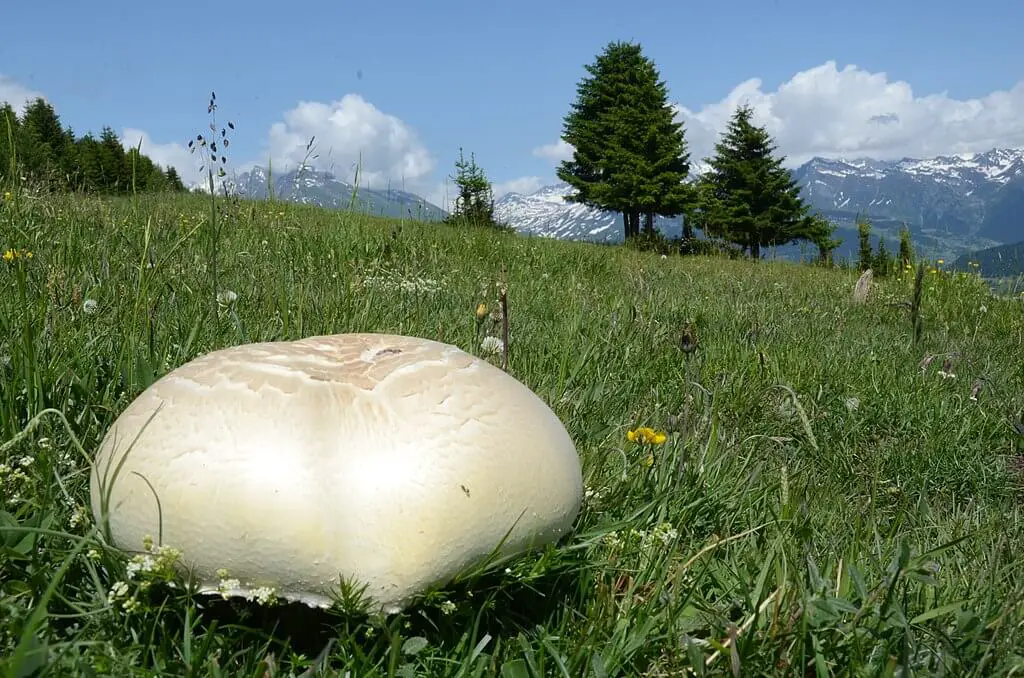
3. Shaggy mane (Coprinus comatus)
The shaggy mane starts as an elongated, egg-shaped cap covered in shaggy, tan to brown scales. The cap eventually opens up, revealing white, gills that darken as the mushroom matures.
Why foragers like them: Shaggy manes are known for their rapid growth. They can appear almost overnight, providing an exciting and quick reward for foragers.
When to forage for shaggy mane?
The summer months, particularly June through August, are a prime time for finding shaggy manes. They thrive in warm and humid conditions.
Shaggy manes should be consumed when young and the gills are still white.
Where to find them?
Shaggy manes are commonly found in grassy areas, including lawns, parks, and meadows. Check gardens and orchards, especially if they have a grassy or mulched ground cover.
Flavor
Shaggy manes have a mild taste. Their flavor is not overpowering, allowing them to complement other ingredients in dishes.
Cooking tips
They are best when fresh. Avoid consuming them once the gills start turning black. Consider sautéing, grilling, or roasting them with minimal ingredients.
Shaggy manes work well in creamy dishes like risottos, pasta, or sauces. Their meaty texture adds substance to the dish.
Recipes to try
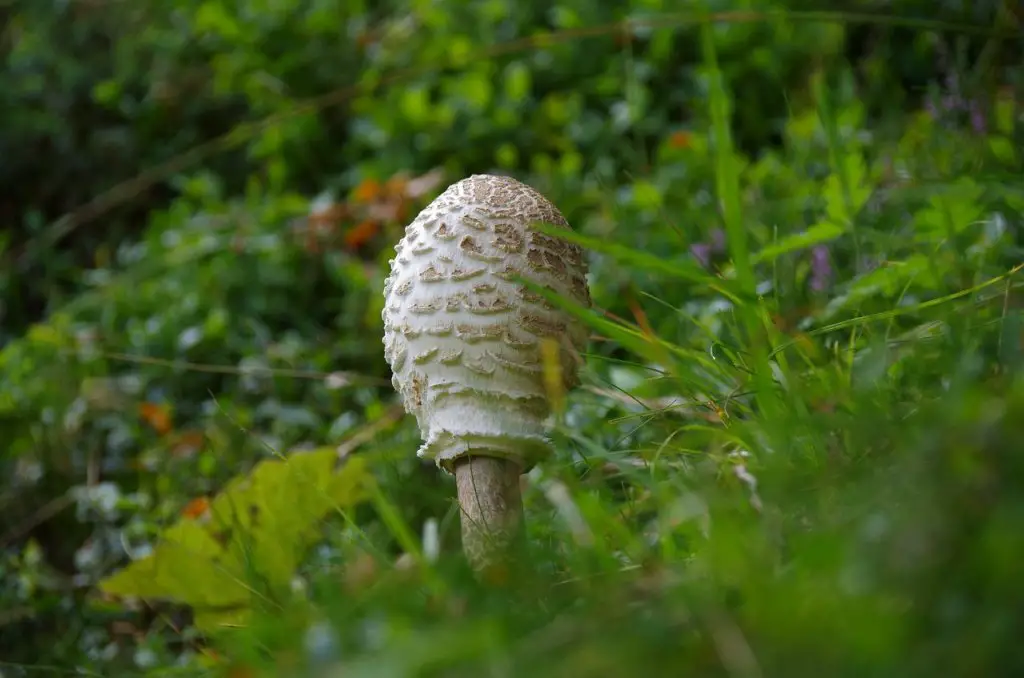
4. Chicken of the Woods (Laetiporus sulphureus)
The mature chicken of the woods has a shelf-like or fan-shaped growth pattern, with overlapping clusters of bright orange to yellow-orange caps. While the mature caps are bright orange, young specimens may display more yellow tones.
Why foragers like them: Chicken of the woods is easy to identify, grows in large quantities under favorable conditions and it’s prized for its taste and texture.
When to forage for chicken of the woods?
Look for them in July and August after periods of rain or high humidity. Harvest chicken of the woods when the edges are soft, the flesh is tender, and the colors are vibrant.
Where to find them?
You’ll want to explore hardwood forests (oak, hickory) and pay attention to the trunks of living or dead hardwood trees. Look for the mushroom on tree trunks, stumps, or the base of trees.
Flavor
The mushroom is often compared to the taste of chicken, especially in its younger stages. When cooked, its texture becomes reminiscent of cooked chicken, making it a popular meat substitute in vegetarian and vegan dishes.
Cooking tips
Consume chicken of the woods promptly after harvesting for the best flavor and texture. It is best when fresh.
Consider sautéing, grilling, or roasting with minimal ingredients. You can also bread chicken of the woods and fry for a crispy texture.
Recipes to try
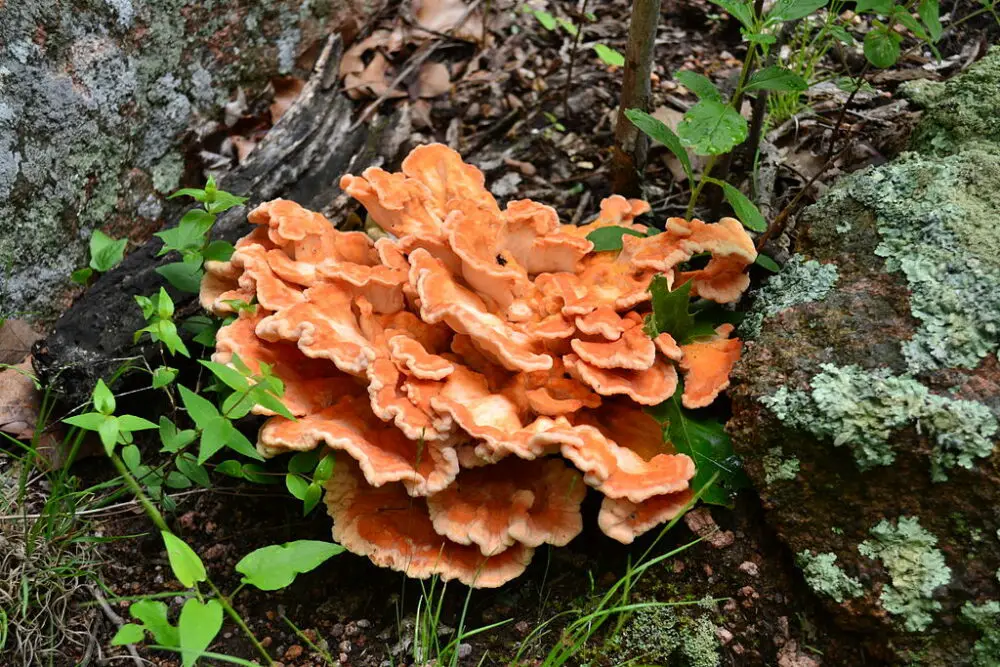
5. Oyster Mushroom (Pleurotus ostreatus)
Oyster mushrooms have oyster-shaped caps and come in various colors, including white and pink. Oyster mushrooms have decurrent gills, meaning they run down the stem.
Why foragers like them: They have a great, visual appeal. They are delicious and are easily recognizable.
When to forage for oyster mushrooms?
Look for them in September through November. Cooler temperatures and increased humidity during the fall can create favorable conditions for their growth.
Where to find them?
Oyster mushrooms grow near hardwood trees, especially deciduous trees like oaks, maples, and beech. Look for them growing on dead or dying hardwood trees, logs, or stumps.
After periods of rain or high humidity, check areas with decaying wood for mushroom growth.
Flavor
Oyster mushrooms have a mild and slightly sweet taste. Some people describe the flavor of oyster mushrooms as having subtle anise or licorice-like undertones.
Cooking tips
Use oyster mushrooms in quick stir-fries. Their thin texture makes them cook rapidly while maintaining a satisfying bite.
Experiment with a variety of seasonings such as soy sauce, balsamic vinegar, or a splash of lemon juice for depth.
Recipes to try
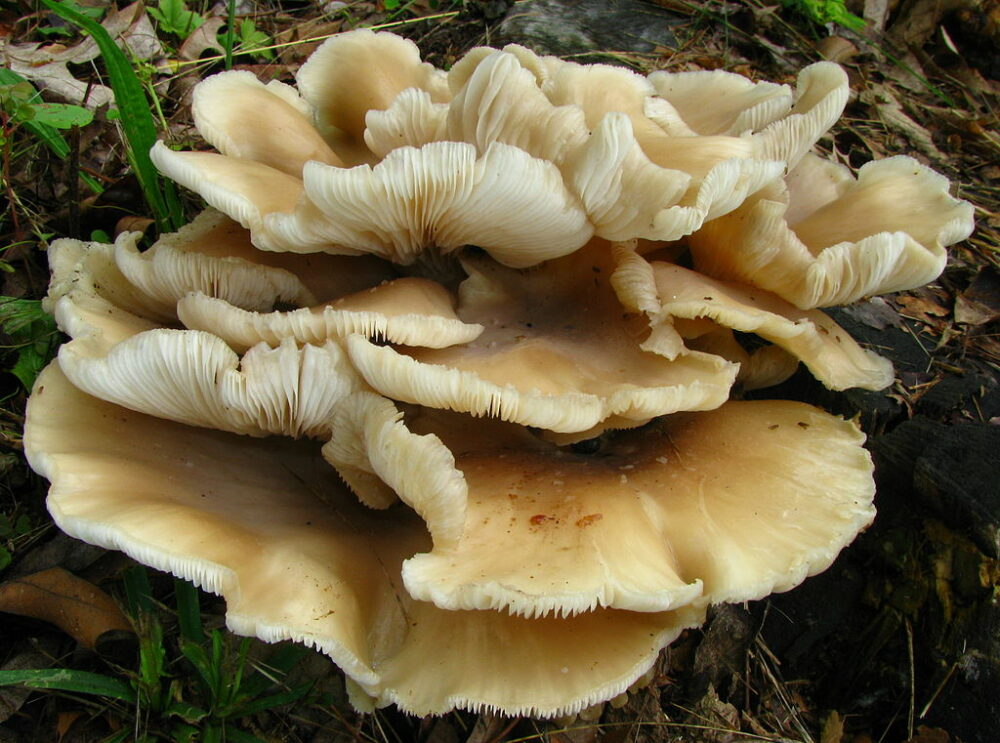
6. Morel mushroom (Morchella)
Ohio is home to several species of morel mushrooms:
- Yellow Morel (Morchella esculenta): It has a distinctive honeycomb appearance with a yellow to tan color.
- Black Morel (Morchella angusticeps): The black morel is characterized by a dark brown to black color. It has a similar honeycomb structure as the yellow morel.
- Half-Free Morel (Morchella punctipes): The half-free morel has a cap that is only attached to the stem halfway down. It is often found in association with tulip poplar trees.
- Bigfoot Morel (Morchella crassipes): The bigfoot morel is a larger and stockier morel species with a distinctive appearance. It is found in hardwood forests.
- Gray Morel (Morchella tomentosa): The gray morel has a gray to tan coloration and a distinctive wrinkled or pitted cap surface. It is found in woodlands and often appears later in the season.
Note: be aware of false morels. Also, check our guide on half free morels.
Why foragers like them: Their seasonal rarity adds to the excitement and anticipation of morel hunting. Plus, they have an exceptional flavor.
When to forage for morels?
Morel mushrooms emerge in the spring, with the season varying from late March to early June. The soil temperature should be around 50 to 60 degrees Fahrenheit (10 to 15 degrees Celsius) for morels to start appearing.
Morels often appear after periods of rainfall.
Where to find them?
Look for areas with trees such as oaks, maples, ash, and tulip poplars. River valleys and areas near water sources can be good locations for morels.
Also, pay attention to certain wildflowers; mayapples or trilliums can sometimes be an indicator that morels are starting to appear.
Flavor
Morels have a rich earthy flavor that is often compared to the essence of the forest floor. When cooked, morels have a meaty and chewy texture.
Cooking tips
Morels can absorb water easily, which can affect their texture. Instead of soaking, lightly rinse them under running water or use a damp cloth to clean.
As with other mushrooms, morels should be seared in oil over high heat to brown them. Morels will soften and brown.
According to some recipes, morels should be cooked in butter from beginning to end, but I have found that the butter burns before the morels are sufficiently browned.
Morels have a distinct flavor, and sometimes, less is more. Use minimal seasoning to allow their natural taste to shine. Salt and pepper can be enough.
Recipes to try
Watch our video to learn all about how to find, forage, and identify morel mushrooms!
7. Field mushroom (Agaricus campestris)
Meadow mushroom, field mushroom, or pink bottom has a light to cream cap. The gills are free from the stem, crowded, and initially pink, turning dark brown as the mushroom matures. The color change is one of the key identification features.
Why foragers like them: Field mushrooms grow in open areas, making them easily accessible.
When to forage for field mushrooms?
Field mushrooms emerge from May to September.
Look for them when the weather is not too hot or too cold. The range of temperatures between 60 to 75 degrees Fahrenheit (15 to 24 degrees Celsius) is ideal.
Where to find them?
Field mushrooms thrive in open spaces with plenty of sunlight. Look for them in well-maintained grassy areas and lawns (parks, golf courses, and open fields).
Flavor
Field mushrooms have a mild, earty and delicate taste. They are meaty and offer a nice bite.
Cooking tips
You can use them anywhere you would use mushrooms. I think these are best butter-sautéed in a pan over medium-high heat.
When the butter is melted, add the field mushroom, tossing to coat evenly with the butter. Field mushrooms have a delicate texture, so avoid overcooking them to prevent a mushy consistency. Cook them until they are just tender.
Recipes to try
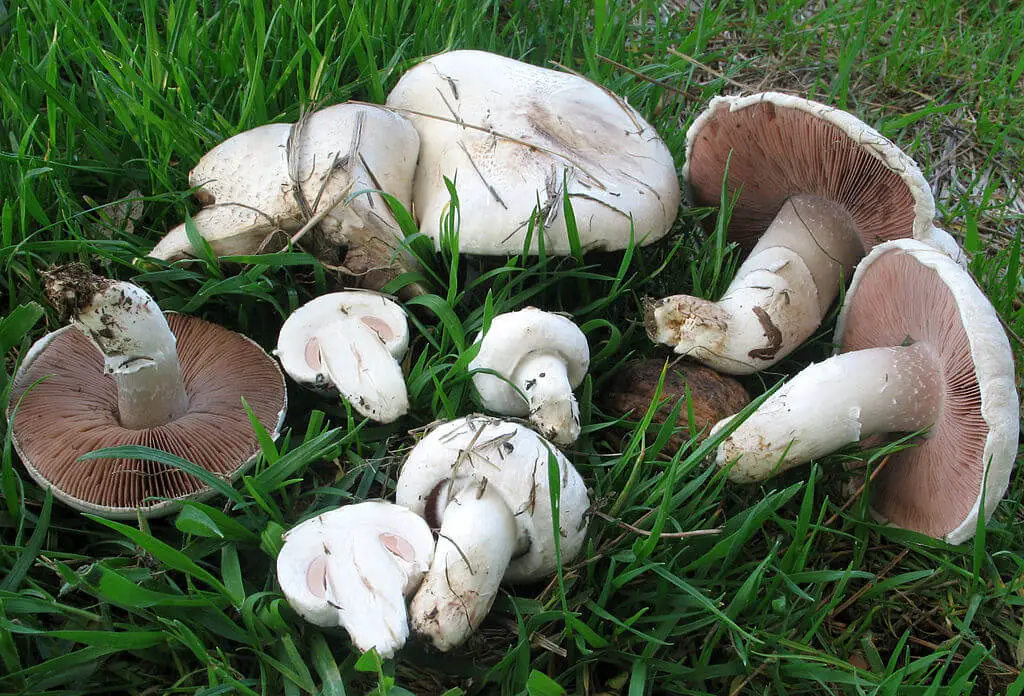
8. Slippery Jack (Suillus luteus)
The cap color varies but is often shades of yellow, brown, or olive. The slimy surface may make it appear more vibrant when wet. The stem is thick, sturdy, and often features a prominent ring or veil. The underside of the slippery jack has tubes instead of gills.
Why foragers like them: Often found in large numbers, especially in coniferous forests.
When to forage for slippery jacks?
The fall months, particularly September and October, are prime time for finding slippery jack mushrooms in Ohio.
Where to find them?
Look for them in areas where conifer trees like pines are abundant. These mushrooms form mycorrhizal connections with the roots of these trees.
Flavor
They have a rich mushroom flavor of slippery jacks and find them reminiscent of shiitake mushrooms.
Cooking tips
The brown sticky part of slippery jacks must be peeled off before eating them, as it is not very digestible. Then cook to your liking.
Recipes to try
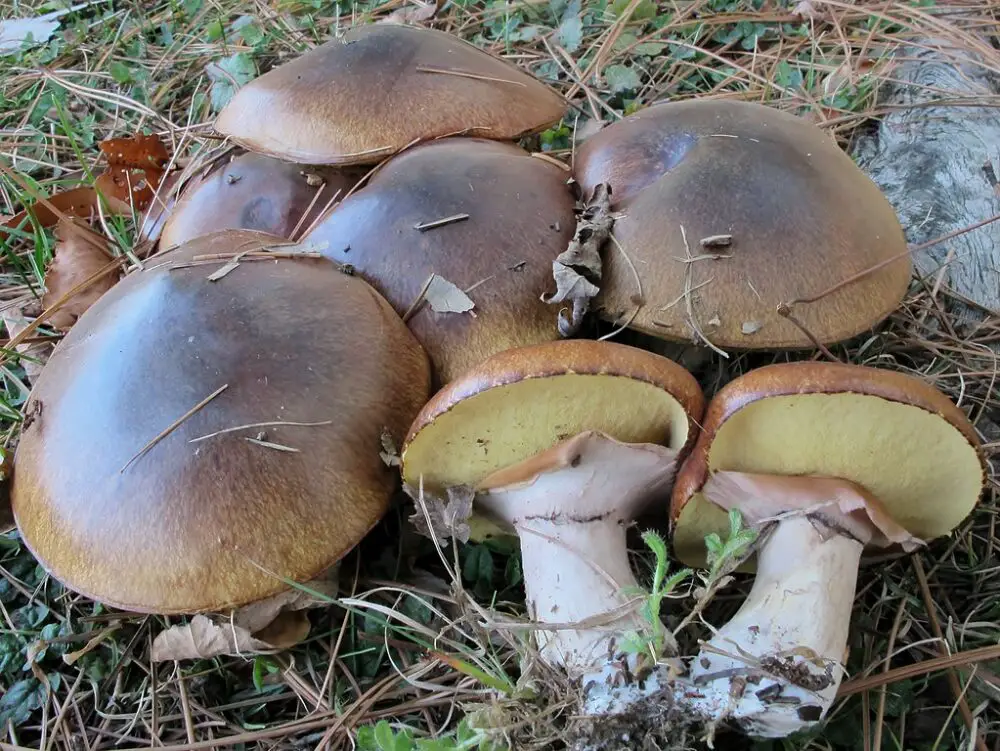
9. Black trumpet (Craterellus cornucopioides)
Black trumpets are trumpet-shaped mushrooms with a dark brown to black color. The entire mushroom, including the cap and stem, is dark brown to almost black.
Why foragers like them: distinctive, smoky flavor. Also, easy recognizable in the wild.
When to forage for black trumpets?
Look for them in September and October.
Where to find them?
Black trumpets are often associated with hardwood forests. Explore areas where oak and beech trees are prevalent.
These mushrooms thrive in damp and shaded locations.
Flavor
Black trumpets are often described as having a rich and smoky flavor. There’s also an unexpected touch of sweetness reminiscent of fresh apricots and ripe stone fruit.
Cooking tips
Black trumpets work well with various proteins such as chicken, beef, or fish. Incorporate black trumpets into creamy sauces, risottos, or soups. The rich flavor of the mushrooms pairs well with the creamy textures
Recipes to try
- Black trumpet ravioli with sage cream sauce
- Chickpeas and rice with black trumpet mushrooms and Iberico ham
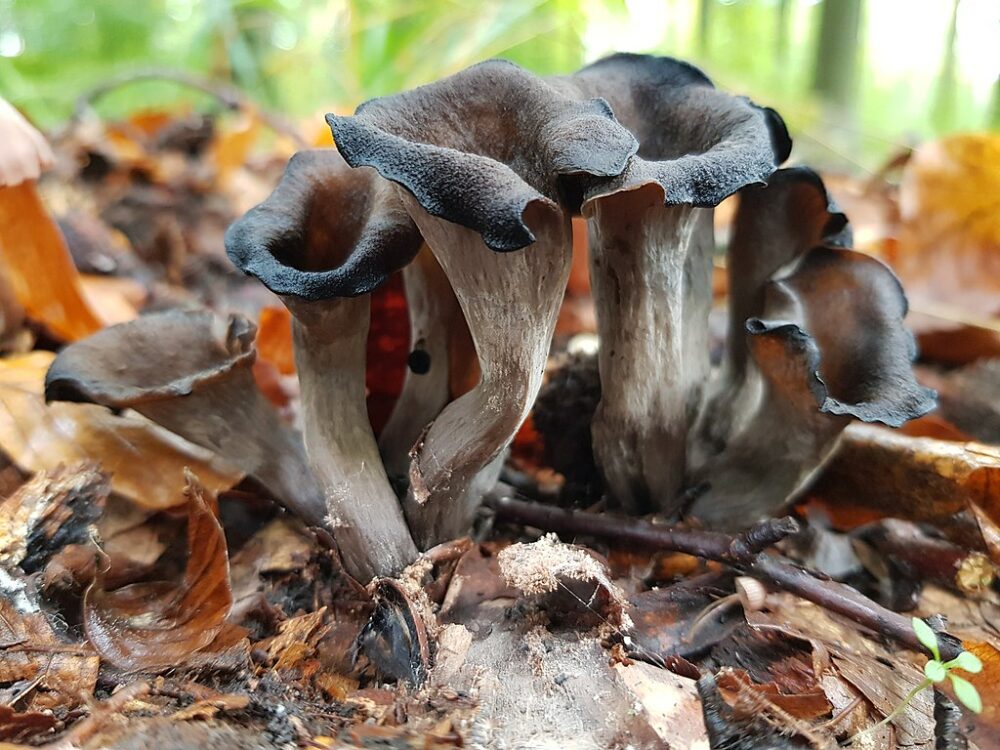
Poisonous mushrooms in Ohio
Below is a list of Ohio’s most common and dangerous mushrooms to look out for.
- Fly Amanita (Amanita muscaria): Reddish-orange, orange to yellow caps with whitish warts. It’s under trees.
- Russula mushroom (Russula sp.):. There are many species in Ohio, in colors like green, yellow, orange, purple, red, white, etc. They’re all woodland and mycorrhizal. There are some edibles and some poisonous ones. The red russulas tend to be poisonous.
- False morels (Gyromitra esculenta): True morels are conical in shape, while false morels are flat. False morels should not be eaten.
- Jack-O-Lantern mushroom (Omphalotus olearius): It’s orange-yellow with gills. Found along stump bases, decaying tree roots.
- Destroying angel (Amanita sp.): Common in mixed woods in Ohio. It is usually found from July to October. It is poisonous and deadly.
- Green-spored lepiota: It is often found in large fairy rings on lawns.
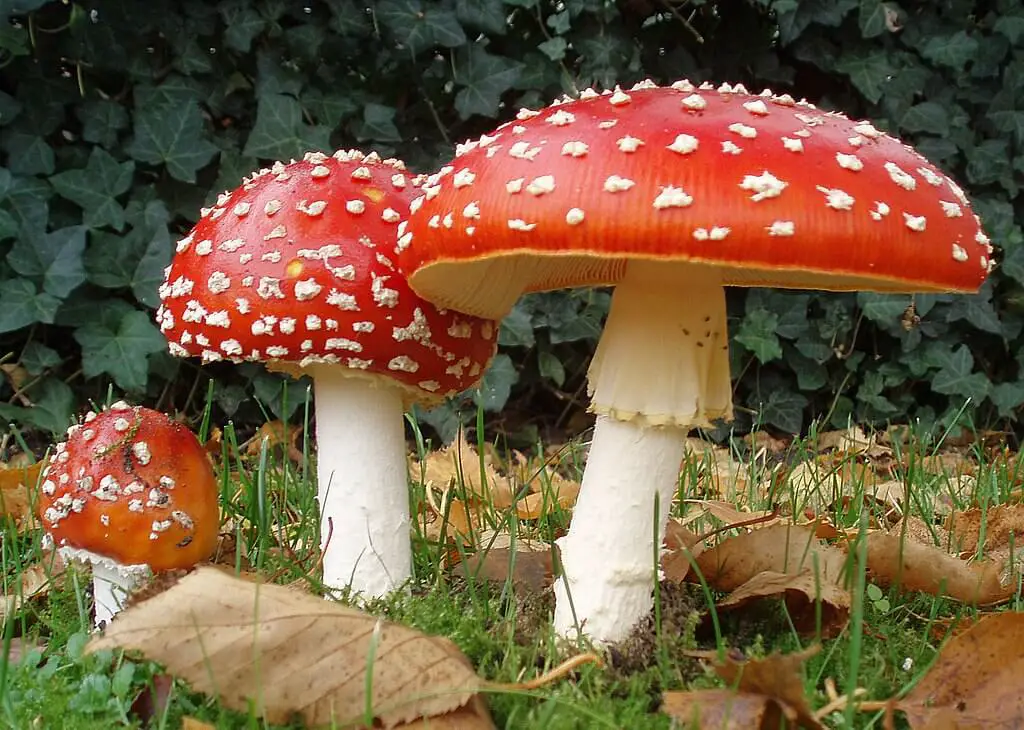
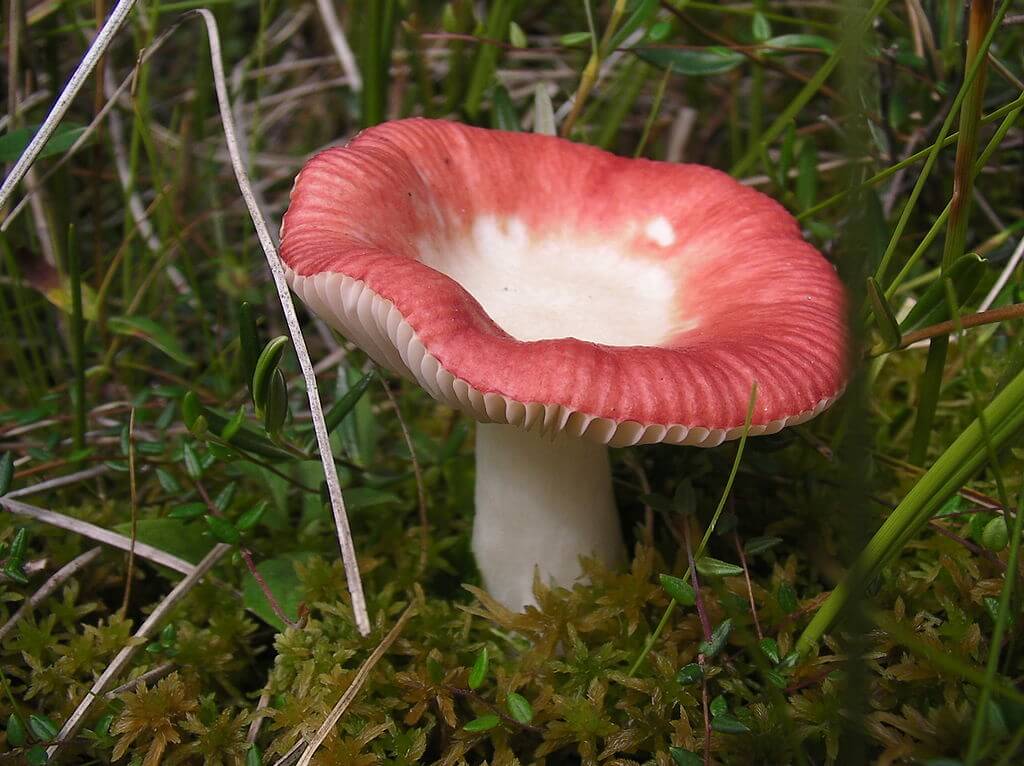
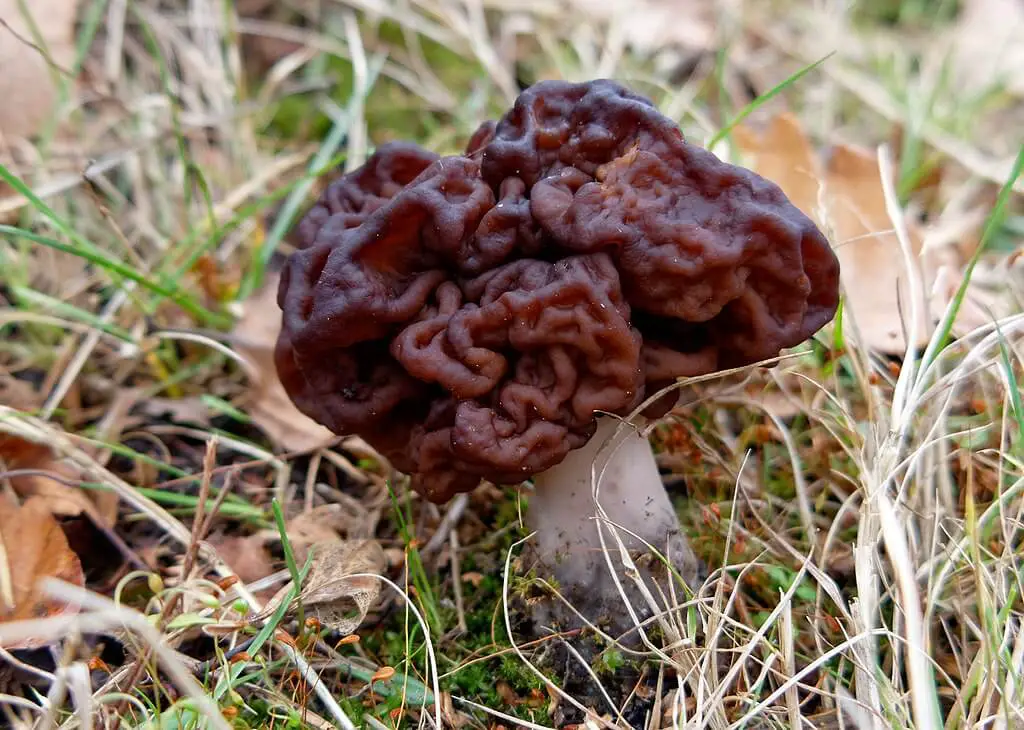
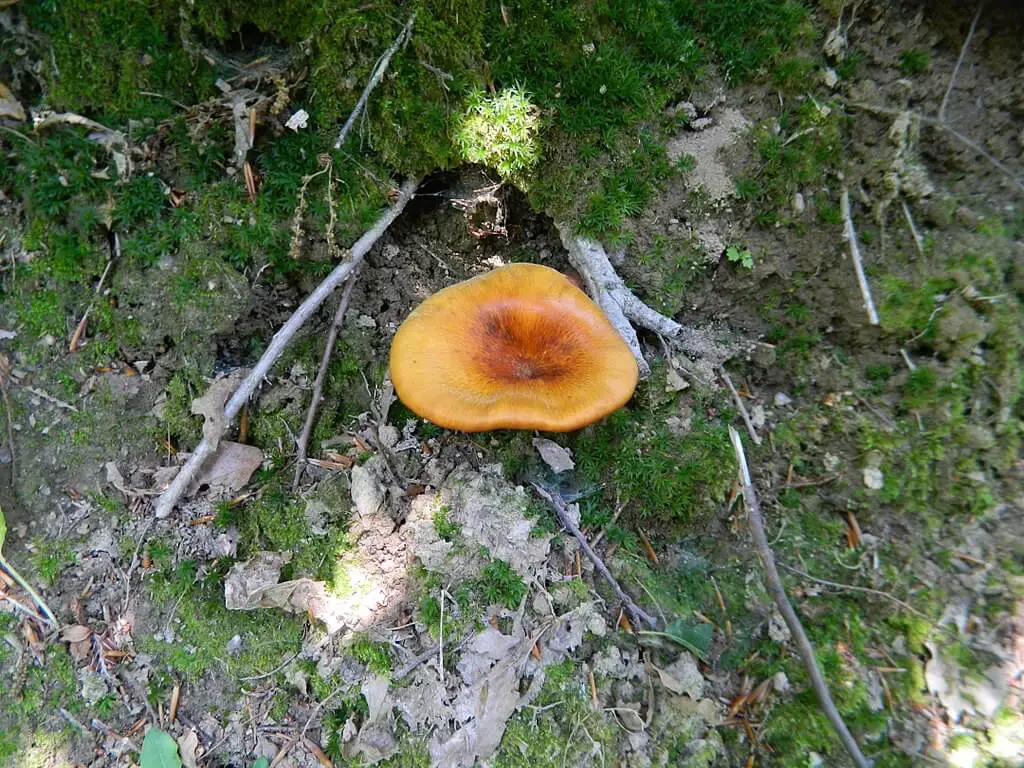
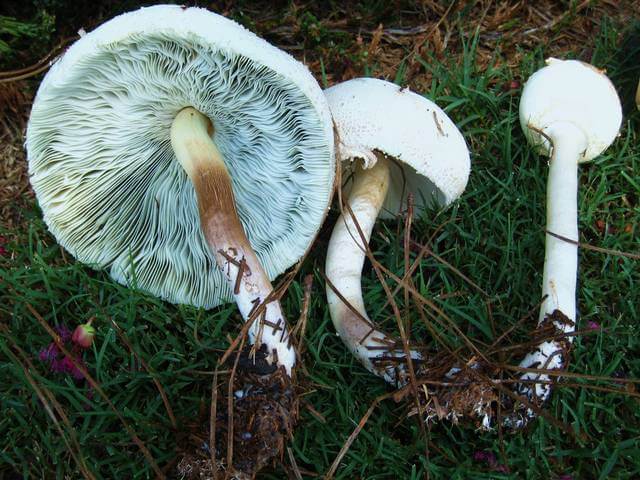
Check our video on the 7 most poisonous mushrooms growing in the US (mushroom details and ingestion symptoms included)!
Foraging tips
- If you are new to the game, you may want to consider joining a state park group or a mushroom society dedicated to foraging mushrooms.
- In Ohio, spring and fall are prime mushroom seasons, and while several species of Ohio mushrooms are suitable for the dinner table, morels are the most passionately pursued.
- Remember that the underground system from which they sprout is preserved by cutting the mushrooms rather than picking them. As a result, the mycological colony continues to produce fruit.
- Be cautious with little brown mushrooms (LBMs); LBMs are a large group of small, brown mushrooms that can be challenging to identify. Exercise caution with LBMs, as some toxic species belong to this category.
- Some mushrooms, especially boletes, change color when bruised. Learn to recognize these color changes, as they can be important for identification.
Ana has always been interested in all things nature and flora. With her expertise in home gardening and interest in foraging, she has been spending her weekends and free time looking for edible native plants, flowers, and fungi. One of her many hobbies includes testing new savory and sweet recipes, juices or teas made from freshly picked plants, wild fruits, or mushrooms.

